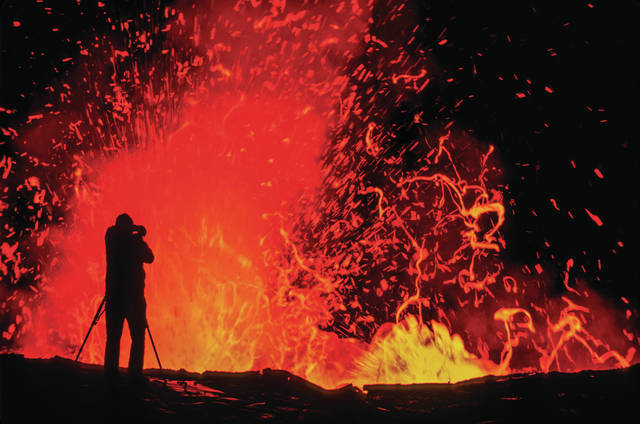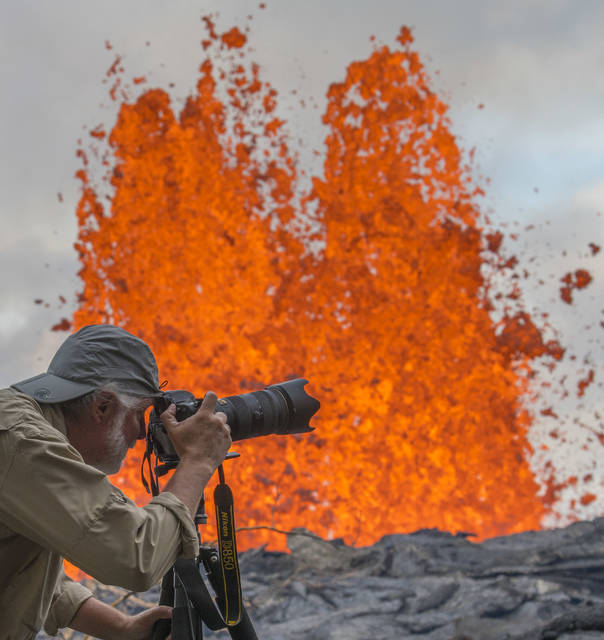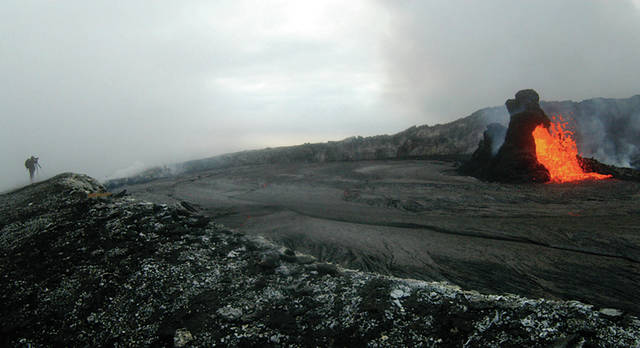Behind the lens: Photographer G. Brad Lewis captures wrath, beauty of Kilauea



KAILUA-KONA — When Kilauea comes alive with all its power, photographer G. Brad Lewis is there to capture it.
KAILUA-KONA — When Kilauea comes alive with all its power, photographer G. Brad Lewis is there to capture it.
Lewis, who first came to Hawaii Island in 1982, has spent decades getting up close and personal with the volcano, including the past few weeks as its most recent eruption has devastated Puna.
However, this time around has been different from what Lewis has photographed before.
“It’s in the middle of a populated neighborhood, for one thing, instead of being remote on the mountain, and it’s very dramatic,” Lewis said. “There’s like 24 fissures now opening up and fountaining lava and it’s impacting us. Two days ago, I was there and I saw over two dozen homes burn — just from being there helping a friend evacuate his house.”
Lewis, who splits his time between Hawaii, Alaska and Utah, said he’s always been drawn to Kilauea over other volcanoes.
“In Alaska, I look at five big volcanoes, and I photograph a lot of volcanoes around the world, but from a distance. I’m just not that interested in being up close and personal to explosive volcanoes that could kill me,” Lewis said. “So, that’s why I chose Kilauea as my primary source of volcanic interest, because it’s user-friendly. It’s a drive-in volcano. Last week, I was shooting fountaining lava in a La-Z-Boy from my friend’s lanai with my feet up on the rail. It’s kind of unique here.”
Lewis’ photographs have been published in magazines such as Life, National Geographic, Time and Newsweek. Lewis said he first became interested in photography as a way to share the beauty of nature.
His Hawaii office is located near Volcano Golf Course, so that he can stay close to Kilauea. It was Kilauea’s initial eruption that made Lewis realize his calling as a volcano photographer.
“I’ve always been doing photography, but I was thinking it was getting time to make is a profession and stop my global traveling and taking photos,” Lewis said. “Fortunately, in 1983, the eruption started, so I was pretty blown away by all that. At one point, it just seemed that this is what I wanted to focus on. It was unique enough and it was just time to do it so I stuck around.”
Those years of experience have made Lewis feel safe, even when he’s near lava flows and active fissures.
“I don’t really get into situations where I get to where I feel like it’s dangerous or will be a close call,” Lewis said. “I don’t feel like I’m in danger. I’ve been around them along enough that I know how to mitigate that and be prepared with the gasses and flows, and a lot of that is just knowing what’s happening that you can’t see.
“Like with these big surges — is there something going to be cutting off a street, and that’s been the biggest concern so far, and is lava crossing the roads where I can’t get out and I’m trapped. And that hasn’t happened because I’ve kept an eye on things, so if something is going to get covered I know that before hand so I can get out of there before hand. I feel relatively safe.”
Still, Lewis is always prepared for the dangers of photographing an active volcano.
“I have everything in my pack that I need: fresh respirator, protective clothing, good boots, headlamp, all the things for my camera so I don’t run out of anything, food, and water,” Lewis said. “I always am in a position where if I have to escape on foot I can do that.”
Being that close pays off for Lewis when it comes to his art, and being that close can only be the result of knowing the right people.
“Even though I distribute my photos around the world, I’m not really the press and I don’t really want to be the press, I’m just me. I’m volcano man guy,” Lewis said. “All the locals know me, and all the locals in charge that are running the show here all know me from 30 years ago. I do have good access from being on the island so long and having the reputation that I do. It’s just totally opened up, and the owners of the homes that are next to lava cones are inviting me in. So there’s a bit of, what I call it, ‘Lewis luck’ going on here where I get where I need to.”
Lewis’ photography has always been focused on nature, and Lewis said he isn’t interested in publishing the effects Kilauea has had on the residents. He said what he loves about being that close to a volcano is having the opportunity to record the power and beauty of it.
“(I want to) have the compassion to not over dramatize it and be sensitive to all the people being impacted by it,” Lewis said. “That’s one thing that I think the national news doesn’t get; there’s a lot going on here with people losing everything and that has to be part of the story and we have to be sensitive to that.
“I’ve been photographing all these homes burning down, but that’s not something I’m going to put out there. I might have a street being covered by lava or a mailbox, to show the human element, but I’m not going to show the homes burning.”
Lewis’ photographs are currently being sold at Blue Seas Artisans Gallery in the Keauhou Shopping Center. During the month of June, 20 percent of sales from Lewis’ photography will be donated to organizations such as Pu’uhonua o Puna to help the communities currently being affected by the lava flows. Ten percent of all sales from the gallery will also be donated to the relief effort, and cash donations are also being accepted.
Artist Stefanie Culbertson Thennes, who works at and showcases her art alongside Lewis at the gallery, said the collective decision to donate was made out of a desire to show that those on the west side of the island care about what is happening in Puna and to create a strong sense of community on the island.
“We want to give back to the community. As artists we feel very strongly connected to this island that we live on and we are all a part of it,” she said. “We want to help out out; we want to make a difference and help those people over there, because we are obviously a little better off on this side.”
On the other side of the island, Lewis gets to see first hand how those communities are being affected.
“The volcano, that’s why these islands are here. Kilauea is doing its thing, it doesn’t mean to cause harm,” Lewis said. “It’s just because of greedy developers and government idiocy years ago that there all these subdivisions on the rift zone that should have never been allowed in the first place. So, unfortunately, humans are being affected.”
In all, the last month has been memorable for Lewis for several reasons.
“It’s kind of two-fold. Of course, I’m enjoying fountaining lava, that’s kind of rare. I like that so many people can see and experience that,” Lewis said. “But I guess it would also be the way the community is pulling together and covering each other and having everybody’s back.”


